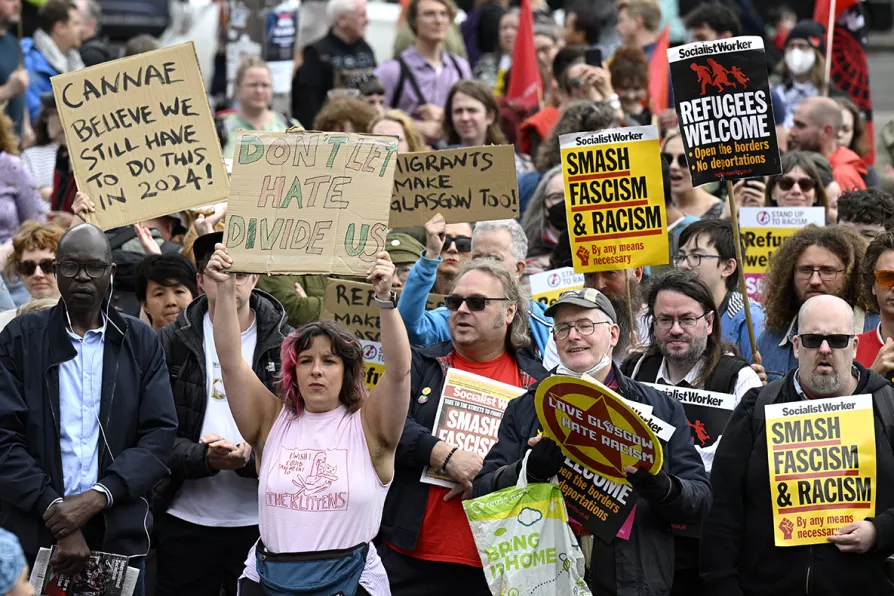Once the bustling heart of Christian pilgrimage, Bethlehem now faces shuttered hotels, empty streets and a shrinking Christian community, while Israel’s assault on Gaza and the tightening grip of occupation destroy hopes of peace at the birthplace of Christ, writes Father GEOFF BOTTOMS
This year’s Bristol Radical History Festival focused on the persistent threats of racism, xenophobia and, of course, our radical collective resistance to it across Ireland and Britain, reports LYNNE WALSH

 Demonstrators during an anti-racism protest organised by Stand Up to Racism, in George Square, Glasgow. Picture date: Saturday August 10, 2024
Demonstrators during an anti-racism protest organised by Stand Up to Racism, in George Square, Glasgow. Picture date: Saturday August 10, 2024
THERE was a moment, in my note-taking at the Bristol Radical History Festival, when I feared that part of this report might be scooped up by the current government, and judged to be an excellent idea.
The presentation in question was on British labour camps, which existed for a decade from 1929, held men in grim conditions, and had them doing hard labour — or risk losing their benefits.
This, to give some important context, was favoured by the Labour government under Ramsay MacDonald.
The talk, Working for your Dole, presented by Roger Ball, was one of 18 at the M Shed venue, on Bristol’s waterfront. The co-operative of volunteers running the festival, now in its seventh year, had gone for three themes: hidden histories of incarceration, radical histories of housing, and Ireland — that last one born from a bond between the Bristol organisers and Dublin’s East Wall History Group.
Ball was quick to admit that, until a few years ago, he hadn’t known of this extraordinary slice of British history, hence his passion in bringing it to our attention. A comrade had found a film, Old Hands, made by the always excellent Platform Films.
“And it fits this theme of incarceration, because it’s not just about people in prison — it’s about where the British state has moved beyond liberal, democratic values.”
Looking to the origins of this idea, Ball focused on Victorian attitudes to dealing with the poor.
There was chronic and abject poverty, “So, Britain was ruling the waves, an imperial power, the most advanced manufacturing industry in the world — but, how to deal with the poor? The more reactionary voices would call them “the social residuum,” the social waste, or the reserve army of labour.”
An earlier idea suggesting that these desperate men might become farmers, “so if we get them to do hard labour in the countryside, they’d go off and start tilling their non-existent land that they don’t own,” led to the notion that they’d somehow get access to land. Or, perhaps they’d provide labour in colonies such as Canada. This cunning stunt on the part of the government failed.
The new idea of “home colonisation” led to the opening, in 1929, of the first Transfer Instructional Centre, and in 1938, there were 28 camps in various locations across Britain.
All men attending the camps had to have been unemployed for a lengthy period, and over the decade, up to 200,000 trainees passed through their gates.
The Old Hands film edited the original government propaganda together with interviews with the real inmates of the camps. The classic cinema verite style reveals a lot, not much of it good. One now elderly man referred to this experiment as “kidnapping” by the state.
The work was brutal, chopping down trees, preparing land for the Forestry Commission, digging ditches and even building roads. Accommodation was grim, the food worse.
The language used to wrap up this intervention is alarming: the long-term unemployed must be hardened. They are “soft human capital.”
Said Ball: “They said they’d gone flabby — I don’t know how you’d get flabby on the dole, in those days!”
The scheme started as voluntary but became coercive. Those on unemployment benefit would have to pay a course fee, “to be in a labour camp! You’re being pauperised, and if you don’t like it, you could lose the whole lot.”
I can see how this strategy appealed to the state. Getting these abandoned, undervalued men away from their communities, where they might well organise and agitate, must have seemed the perfect plan.
Labour camps in Wales were located at Brechfa, Llansawel, Presteigne, Ganllwyd and Betws-y-Coed.
I find that unbearably moving. The men were removed from hearth and home and sent to do back-breaking work. These areas are now nature reserves, full of steep gorges and tumbling waterfalls. The trekking there is not for the faint-hearted.
Hearing that there was resistance made my heart swell.
There was malingering, said Ball, with a wry smile and a recollection of his own youth on government schemes.
There was involvement, too, from the National Unemployed Workers’ Movement (NUWM), which had been set up in 1921, committed to opposing means testing. By 1932, it was organising marches across Britain, with the theme “Struggle or Starve.”
There were publications, too, from those revealing the reality of the labour camps. It gladdened me to see that one of the samizdat bulletins had been produced by Lewis Jones, Rhondda checkweighman, south Wales communist, Wales NUWM organiser, and firebrand for his class.
Although the government of the day was Labour, said Ball, they were not immune to ideas of deserving or undeserving poor.
Among the Irish visitors was Padraig Og O Ruairc, whose presentation on the history of fascism and the far right in Ireland was packed with detail, wit and the chilling reminder that xenophobia may always lurk beneath the surface.
When teenager Axel Rudakubana murdered three children in Southport last summer, rioters took to the streets in Dublin, as well as Britain. Buses and cars were torched, areas of the city wrecked and centres designed to house refugees fell to the arsonists’ torches.
O Ruairc’s response was to look at the roots of this racism, and unearth the long and complex history behind it. His book, Burn Them Out!, was published recently by Bloomsbury.
Introducing the author was Joe Mooney of the East Wall group, and Anti Fascism Action (AFA) Ireland, who said the book, had it been launched five years ago, “would have been a very welcome history book. Now, it’s part history and part current affairs, unfortunately.
“Over the past number of years, Ireland has witnessed an unprecedented escalation of anti-immigration protests and the emergence of far-right agitators as political figureheads.
“As long as I can remember, Irish people always prided themselves on not being racist. What we’re probably finding out now is that we had nobody to be racist against, in our country. Maybe we’ve been too complacent in thinking that this couldn’t happen to us.”
It should not be surprising, he said, “as Irish fascists have always displayed a willingness to jump into bed with any bigots that would have them.”
O Ruairc spoke of the ultra-Catholic, anti-communist Irish movements that got a grip on society, with the British Fascisti marching through Dublin, in the ’20s and ’30s, and incurring the wrath of the IRA, who burned down its headquarters.
Among the big-name bigots of the time was William Joyce, infamous as Lord Haw-Haw during World War II.
“A fascinating thing is — you see the scar, running from his cheek up to his ear. He’d always tell people that he got that from a male Jewish communist who attacked him. However, his first wife Heather told his biographer that Haw-Haw had been attacked by an Irish woman [a member of Cumann na mBan, the IRA women’s auxiliary], who went up and slashed him in the face with a knife.”
No account of fascism would be complete without a mention of Oswald Mosley, and O Ruairc outlined the British Union of Fascists’ strategy, in setting up Ulster Fascists, “to unite green Catholic nationalists and orange Protestant loyalists in their combined hatred of Jewish people, and of foreigners. That was Mosley’s dream. It did not fly in Ireland.”
The successful opposition came, he said, from the Irish left, republican socialists and trade unionists, regardless of religion.
Far more successful, he said, were the Blueshirts, forerunners of Fine Gael. Of the latter, said O Ruairc, Irish academics would claim they were not fascists.
“They will say they were proto-fascists, para-fascists, quasi fascists, closet fascists, I can’t believe it’s not fascist! Now, the party today is not fascist, but when it was founded, it certainly was.”
Only the naive optimist would think that these far-right, ultra-nationalist gremlins would stay buried. A modern visitor to Belfast might see a swastika flying alongside the US Confederate flag, in some loyalist areas. In March this year, graffiti near Queen’s University was quickly removed. The “Go Nationalist or Go Extinct” slogan had a swastika scrawled alongside.
The old struggle continues, and I, for one, am delighted that AFA is squaring up to racists in their communities.
From this packed, thought-provoking festival of radical ideas, I’m left with a quieter thought, from Quaker and Just Stop Oil protester Gaie Delap.
Now in her late seventies, she fell victim to the criminalisation of non-violent protest. Having climbed a gantry over the M25, halting some 700,000 drivers in tailbacks, Delap was arrested, convicted and served three-and-a-half months in Peterborough prison.
We observed her faith by joining her in a moment’s silence as she began her talk. Her message: “Activism is the antidote to despair.”
Delap speaks truth to power. We should be with her, all the way.

Once again Tower Hamlets is being targeted by anti-Islam campaigners, this time a revamped and radicalised version of Ukip — the far-right event is now banned by the police, but we’ll be assembling this Saturday to make sure they stay away, says JAYDEE SEAFORTH

LYNNE WALSH reports from the Morning Star’s Race, Sex and Class Liberation conference last weekend, which discussed the dangers of incipient fascism and the spiralling drive to war

LYNNE WALSH previews the Bristol Radical History Conference this weekend











